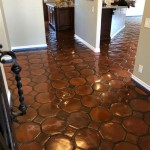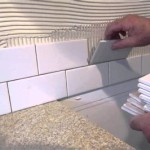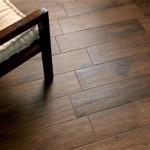Can You Lay Lino On Top Of Floor Tiles? A Comprehensive Guide
The question of whether linoleum (lino) can be laid directly over existing floor tiles is a common one for homeowners undertaking renovation projects. The answer, while seemingly straightforward, is nuanced and depends on several factors relating to the condition of the existing tile floor and the desired final result. Properly assessing these factors is crucial to ensure a successful and long-lasting installation.
Laying lino over tiles can be a viable option for updating a floor without the extensive labor and cost involved in removing the existing tiles. Tile removal can be messy, time-consuming, and may even require professional assistance, especially if asbestos is suspected. Covering the tiles with lino offers a potentially faster and cleaner alternative. However, shortcuts can often lead to problems down the line, so meticulous preparation is paramount.
The inherent properties of linoleum make it somewhat forgiving, but it is not a magic bullet for covering up imperfections. Linoleum is a relatively thin and flexible material. Any unevenness, cracks, or grout lines in the underlying tile floor can telegraph through to the lino surface over time. This can not only detract from the aesthetic appeal but can also compromise the integrity of the lino, leading to premature wear and tear.
Assessing the Condition of the Existing Tiles
A thorough inspection of the existing tile floor is the crucial first step. The assessment should focus on several key areas: stability, evenness, and the integrity of the grout lines. Each of these aspects can significantly impact the success of laying lino on top.
Stability: Any loose, cracked, or damaged tiles must be addressed before proceeding. Loose tiles will create movement under the lino, which can cause it to crack, tear, or become uneven. Loose tiles should be carefully removed, and the subfloor beneath them cleaned and repaired. Replacing the removed tiles with new ones is the ideal solution, ensuring they are level with the surrounding tiles. If matching tiles are unavailable, a cement-based patching compound can be used to fill the gaps, creating a smooth and level surface.
Evenness: Perfectly level tiles are rarely encountered in older installations. Even minor height variations between tiles can become noticeable under the lino. A long level or straight edge should be used to identify any significant dips or ridges in the tile floor. Areas that are significantly uneven may require the application of a self-leveling compound. This compound is poured over the entire floor and allowed to flow, creating a perfectly level surface once dried. It is essential to choose a self-leveling compound suitable for use over tile and to follow the manufacturer's instructions carefully.
Grout Lines: Grout lines, even when in good condition, represent depressions in the floor surface. These depressions are prone to telegraphing through the lino, creating a visible grid pattern. Addressing the grout lines is essential for achieving a smooth and professional-looking finish. The most common method is to fill the grout lines with a cement-based grout filler. This filler should be applied evenly, ensuring it is flush with the surface of the tiles. Once the filler has dried, it should be sanded smooth to eliminate any excess and create a seamless transition between the tiles and the grout lines.
In addition to these primary concerns, it’s important to check for any signs of moisture damage. If the existing tile floor is in a damp or humid environment, it's possible that moisture will be trapped beneath the lino, leading to mold and mildew growth. This can not only damage the lino but also create health hazards. Ensure the underlying floor is completely dry before proceeding with the installation.
Preparing the Tile Surface for Lino Installation
Once the existing tiles have been thoroughly assessed and any necessary repairs have been made, the next step is to prepare the surface to ensure proper adhesion of the lino. This involves cleaning, sanding, and potentially priming the tile surface.
Cleaning: The tile surface must be thoroughly cleaned to remove any dirt, grease, wax, or other contaminants. A strong degreasing cleaner is recommended, followed by a rinse with clean water. Allow the floor to dry completely before proceeding.
Sanding: Sanding the tile surface creates a slightly textured surface that provides better adhesion for the lino adhesive. A medium-grit sandpaper (around 100-120 grit) should be used. The goal is not to remove the tile finish entirely but rather to create a slightly roughened surface. It is essential to wear a dust mask during sanding to avoid inhaling tile dust. After sanding, the floor should be vacuumed thoroughly to remove all sanding dust.
Priming: Priming the tile surface can further enhance adhesion and create a more uniform surface for the adhesive to bond to. A primer specifically designed for use over non-porous surfaces like tile is recommended. Follow the manufacturer's instructions for application and drying time. Priming is particularly important if the tiles have a glossy or very smooth finish, as this will significantly improve the bond between the tile and the lino adhesive.
After completing these steps, the tile floor should be clean, level, and properly prepared to receive the lino. Taking the time to meticulously prepare the surface will significantly increase the likelihood of a successful and long-lasting installation.
Selecting the Appropriate Lino and Adhesive
The choice of linoleum and adhesive is another critical factor in determining the success of the project. Not all lino is created equal, and selecting a product suitable for the intended use is essential. Similarly, using the correct adhesive is crucial for ensuring a strong and durable bond between the lino and the prepared tile surface.
Lino Selection: Consider the intended use of the room where the lino is being installed. Heavy foot traffic areas, such as hallways and kitchens, will require a more durable and hard-wearing lino than less frequently used rooms like bedrooms. Lino is available in various thicknesses and wear layers. A thicker lino with a higher wear layer will provide better resistance to scratches, dents, and other forms of damage. Consider also the pattern and color of the lino. Darker colors and more complex patterns tend to hide imperfections better than lighter colors and solid patterns. Sheet lino is generally preferred for larger areas, as it minimizes seams. However, lino tiles or planks can be easier to install in smaller or irregularly shaped rooms.
Adhesive Selection: The adhesive plays a vital role in ensuring the lino stays firmly in place and resists movement. A high-quality lino adhesive specifically designed for use over non-porous surfaces like tile should be selected. These adhesives are formulated to provide a strong and durable bond, even under heavy traffic conditions. Read the manufacturer’s specifications carefully to ensure the adhesive is compatible with both the lino and the tile. Consider also the drying time and open time of the adhesive. Faster-drying adhesives may be more convenient, but they may also leave less time for positioning the lino. Some adhesives may require applying a thin coat to both the tile and the lino (referred to as double-bonding), while others only require application to the tile. Always follow the manufacturer's instructions carefully.
When selecting the lino and adhesive, it’s also wise to consider their environmental impact. Opt for products that are low in VOCs (Volatile Organic Compounds) to minimize indoor air pollution. Natural linoleum, made from renewable resources, is an environmentally friendly choice.
Proper selection of lino and adhesive, based on the specific requirements of the project, is a key ingredient for a successful and durable installation. Investing in high-quality materials will pay off in the long run by minimizing the risk of problems and extending the lifespan of the floor covering.
In summary, while it is possible to lay lino on top of floor tiles, success hinges on careful assessment, thorough preparation, and the selection of appropriate materials. Neglecting any of these aspects can lead to unsatisfactory results and potentially costly repairs. Therefore, taking the time to do the job correctly is essential for achieving a beautiful and long-lasting floor.

Installing Luxury Vinyl Over Existing Tiles Choices Flooring

How To Tile Over Linoleum Floors Correctly

Transform Your Home Installing Vinyl Flooring Over Ceramic Tiles City Wall And Floor

Can You Lay Tile Over Linoleum Rubi Blog Usa

How To Install Luxury Vinyl Tile Over Linoleum

How To Install Vinyl Plank Floors In A Bathroom Over Tile

Can You Lay Vinyl Flooring Over Tile Mersey

How To Lay Sheet Vinyl Flooring

What Type Of Flooring Can You Install Over Ceramic Tile

How To Install Luxury Vinyl Tile Over Linoleum
Related Posts








